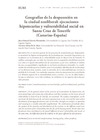Please use this identifier to cite or link to this item:
https://accedacris.ulpgc.es/handle/10553/106073
| Title: | Geografías de la desposesión en la ciudad neoliberal: ejecuciones hipotecarias y vulnerabilidad social en Santa Cruz de Tenerife (Canarias-España) | Authors: | García-Hernández, Juan-Samuel Ginés De La Nuez, M Carmen |
UNESCO Clasification: | 540401 Geografía urbana 6310 Problemas sociales 631011 Bienestar social |
Keywords: | Transformaciones socioterritoriales Política habitacional Periferia urbana Socio-territorial transformations Housing policy, et al |
Issue Date: | 2020 | Project: | “Crisis y vulnerabilidad en ciudades insulares es-pañolas. Transformaciones en los espacios de reproducción social” (CSO2015-68738-P) financiado por el Plan Nacional de I+D+i del Ministerio de Ciencia e Innovación. | Journal: | Eure | Abstract: | En el contexto general de los procesos de acumulación por desposesión, se examinan las lógicas socioespaciales de los desalojos por ejecución hipotecaria y su incidencia en la extensión de la vulnerabilidad social en Santa Cruz de Tenerife. El análisis contempla, por un lado, los vínculos entre la expansión inmobiliaria anterior a la crisis y el reparto intraurbano de las ejecuciones; y, por otro, mediante el análisis de caso, su espacialidad y significado en un barrio socialmente vulnerable. La combinación de métodos permite estudiar tanto la intensidad y distribución de los desalojos en las distintas áreas sociales, como la extensión de la vulnerabilidad que entraña la pérdida de la vivienda. Los resultados muestran cómo las ejecuciones han contribuido a la difusión espacial de la vulnerabilidad social y revelan, a la vez, las dificultades a las que se enfrentan, en su vida cotidiana, los residentes en los espacios afectados por tales procesos. In the general context of the processes of accumulation by dispossession, the socio-spatial logics of evictions due to foreclosure and their incidence on the extent of social vulnerability in Santa Cruz de Tenerife, are examined. The analysis contemplates, on the one hand, the links between the real estate expansion prior to the crisis and the intra-urban distribution of mortgage foreclosures and, on the other, through case analysis, its spatiality and meaning in a socially vulnerable neighborhood. The combination of methods allows the analysis of the intensity and distribution of the evictions in the different social areas and the extension of the vulnerability that the loss of the housing entails. Results show how foreclosures have contributed to the spatial diffusion of social vulnerability and reveal, at the same time, the difficulties faced by residents in the spaces affected by such processes. |
URI: | https://accedacris.ulpgc.es/handle/10553/106073 | ISSN: | 0250-7161 | DOI: | 10.4067/S0250-71612020000200215 | Source: | EURE [0250-7161], vol.46 nº 138, (May 2020), p. 215-234 |
| Appears in Collections: | Artículos |
Page view(s)
77
checked on Jan 28, 2024
Download(s)
53
checked on Jan 28, 2024
Google ScholarTM
Check
Altmetric
Share
Export metadata
Items in accedaCRIS are protected by copyright, with all rights reserved, unless otherwise indicated.
